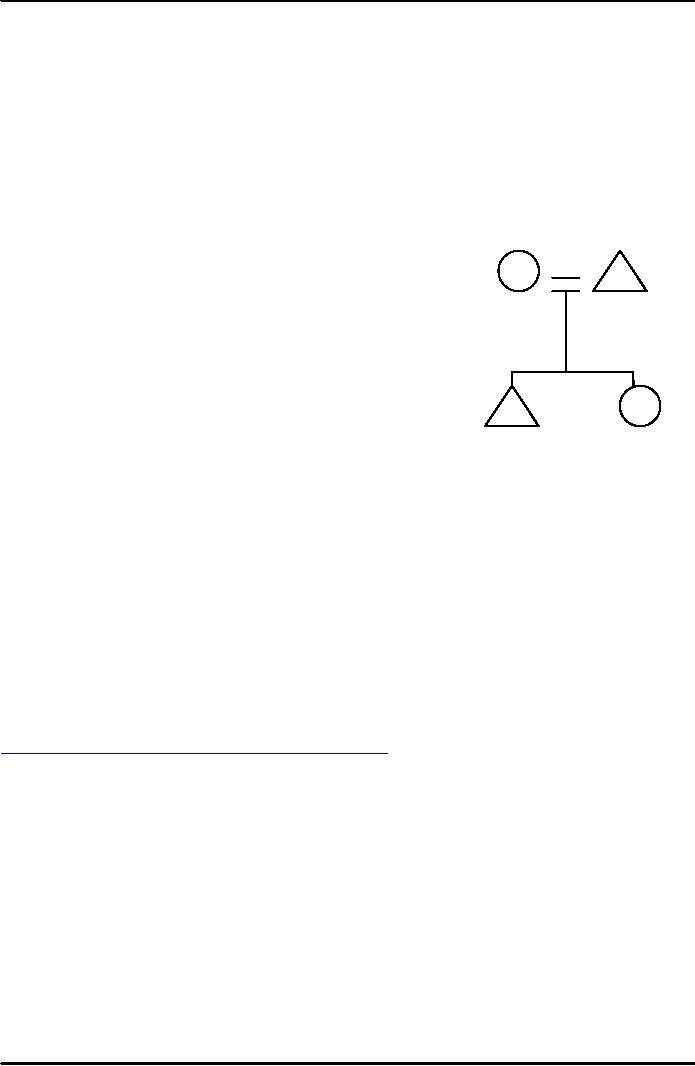 |

Introduction
to Cultural Anthropology
SOC401
VU
Lesson
15
KINSHIP
AND DESCENT (continued)
Tracing
Descent
In
societies that trace their
descent unilineally, people recognize
that they belong to a particular
unilineal
descent
group or series of groups. Sixty
percent of cultures in the world
are unilineal. Unilineal
groups are
adaptive
and clear-cut social units,
based on birthright, which in
turn influence inheritance, marriage
and
prestige
issues
Kinship
Organization
Kinship
is
organized on the basis of different
groups of varying sizes:
Lineages
are
based on a set of kin who
can trace their ancestry
back through known
links
Clans
are
unilineal groups which claim
descent but they are unable
to trace all their
genealogical links
Phratries
are
groups of related
clan
Moieties
are
two halves of a society
related by descent
Bilateral
Descent
A
person is related equally to
both sides of the family on the
basis of bilateral descent. This
form of descent
is
prevalent in foraging and industrialized
societies. Bilateral systems are
symmetrical and result in
the
formation
of kindred, which are loose
kinship networks rather than being
permanent corporate functioning
groups.
Double
Descent
A
double unilineal descent
system is one where
descendents are traced matrineally
and patrineally. As a
result,
both sides of the family
have a useful social
function such as enabling inheritance.
Under this system,
it
is possible for moveable
property such as livestock or agricultural
produce to be inherited from
the
mother's
side, whereas non-moveable property
(land) may be inherited from the
father's side. This system
is
found
in only 5% of world cultures
(for e.g. the Yako in
Nigeria).
Primary
Kinship Systems
There
are six basic types of
kinship systems used to
define how cultures distinguish
between different
categories
of relatives.
Eskimo
are
found in one-tenth of the world
societies, this system involves bilateral
descent, focusing on
nuclear
relations and lumping external relatives
(cousins, uncles and
aunts).
Hawaiian
are
found in a third of world
societies, this system uses the
same term for all relatives
of the
same
gender and generation, so the term
mother
is
used not only for the
mother but also for
her sisters and
the
father's sisters. Cousins
are termed brothers and
sisters. This is an ambivalent system,
which submerges
the
nuclear family into a larger
kinship group.
Iroquois
are a
less prevalent system which
emphasizes the importance of unilineal
descent groups by
distinguishing
between members of one's own
lineage and those belonging
to other lineages.
Sudanese
are
the system is named after the country
where the system was first
identified. It is the most
pluralistic
system since it makes the
most terminological distinctions.
36

Introduction
to Cultural Anthropology
SOC401
VU
Omaha
emphasizes
patrilineal descent, the father
and his brothers are referred to by the
same term and the
paternal
cousins are called siblings,
but cross cousins are
referred to by separate terms. On the mother's
side
there
is a merging of generations, all her
male relatives are called
mother's brother.
Crow
is the
exact opposite of the Omaha system, as it
emphasizes maternal relations which
are all
important
for determining the descent group of
children.
Kinship
Diagrams
Cultural
Anthropologists often use
kinship diagrams to help
explain family structures,
which use simple
symbols
for males and females,
and to indicate what their relationships
are to each other.
The
diagram below depicts a
married couple and their
two children (a son and a
daughter):
Useful
Terms
Descent:
established
linage
Ambivalent:
unclear
Influence:
power
Social
function: the particular
purpose served for
society
Prestige:
Social
honor or respect within a
society
Suggested
Readings
Students
are advised to read the
following chapters to develop a better understanding
of the various
principals
highlighted in this hand-out:
Chapter
10 in `Cultural
Anthropology: An Applied Perspective' by
Ferrarro and/or Chapter 21 in
`Anthropology' by
Ember
and Pergrine
Internet
Resources
In
addition to reading from the
textbook, please visit the
following web-pages for this
lecture, which
provide
useful and interesting
information:
Descent:
Terms and Concepts
http://reference.allrefer.com/encyclopedia/D/descent.html
37
Table of Contents:
- WHAT IS ANTHROPOLOGY?:Cultural Anthropology, Internet Resources
- THE CONCEPT OF CULTURE AND THE APPLICATION OF CULTURAL ANTHROPOLOGY
- MAJOR THEORIES IN CULTURAL ANTHROPOLOGY:Diffusionism
- GROWTH OF ANTHROPOLOGICAL THEORY (continued):Post Modernism
- METHODS IN CULTURAL ANTHROPOLOGY:Comments on Fieldwork
- METHODS IN CULTURAL ANTHROPOLOGY (continued):Census Taking
- COMPARATIVE STUDY OF PRODUCTION, DISTRIBUTION AND CONSUMPTION IN DIFFERENT PARTS OF THE WORLD
- ECONOMIC ANTHROPOLOGY (continued):THE DISTRIBUTION OF GOODS AND SERVICES
- FOCUSING ON LANGUAGE:Languages of the World, Structure of Language
- FOCUS ON LANGUAGE (continued):Levels of Complexity, Cultural Emphasis
- OBTAINING FOOD IN DIFFERENT CULTURES:Optimal Foraging, Suggested Readings
- FOOD AND CULTURE (continued):Food Collectors, Food Production
- OBTAINING FOOD IN DIFFERENT CULTURE (continued):Pastoralism, Agriculture
- RELEVANCE OF KINSHIP AND DESCENT:Kinship Criteria, Rules of Descent
- KINSHIP AND DESCENT (continued):Tracing Descent, Primary Kinship Systems
- THE ROLE OF FAMILY AND MARRIAGE IN CULTURE:Economic Aspect of Marriage
- ROLE OF FAMILY AND MARRIAGE IN CULTURE (continued):Family Structures
- GENDER AND CULTURE:Gender Stratification, Suggested Readings
- GENDER ROLES IN CULTURE (continued):Women Employment, Feminization of Poverty
- STRATIFICATION AND CULTURE:Social Ranking, Dimensions of Inequality
- THEORIES OF STRATIFICATION (continued):The Functionalists, Conflict Theorists
- CULTURE AND CHANGE:Inventions, Diffusion, Donor, Conventional
- CULTURE AND CHANGE (continued):Cultural Interrelations, Reaction to Change
- CULTURE AND CHANGE (continued):Planned Change, Globalization
- POLITICAL ORGANIZATION:Bands, Tribal Organizations, Chiefdoms
- POLITICAL ORGANIZATION (continued):State Systems, Nation-States
- POLITICAL ORGANIZATION (continued):Social Norms, Informal Mechanisms
- PSYCHOLOGY AND CULTURE:Emotional Development, Psychological Universals
- PSYCHOLOGY AND CULTURE (continued):Origin of Customs, Personality Types
- IDEOLOGY AND CULTURE:Ideology in Everyday Life, Hegemony
- IDEOLOGY AND CULTURE (Continued):Political ideologies, Economic Ideology
- ASSOCIATIONS, CULTURES AND SOCIETIES:Variation in Associations, Age Sets
- ASSOCIATIONS, CULTURES AND SOCIETIES (continued):Formation of Associations
- RACE, ETHNICITY AND CULTURE:Similarity in Human Adaptations
- RACE, ETHNICITY AND CULTURE (continued):Inter-group Relations
- CULTURE AND BELIEFS:Social Function of Religion, Politics and Beliefs
- LOCAL OR INDIGENOUS KNOWLEDGE:Changing Definitions of Local Knowledge
- LOCAL OR INDIGENOUS KNOWLEDGE (continued):The Need for Caution
- ANTHROPOLOGY AND DEVELOPMENT:Influence of Development Notions
- ANTHROPOLOGY AND DEVELOPMENT (Continued):Contentions in Development
- ANTHROPOLOGY AND DEVELOPMENT (Continued):Operational
- CULTURAL ANTHROPOLOGY AND ART:Relevance of Art, Art and Politics
- CULTURAL ANTHROPOLOGY AND ART (continued):Art as a Status Symbol
- ETHICS IN ANTHROPOLOGY:Ethical Condemnation, Orientalism
- RELEVANCE OF CULTURAL ANTHROPOLOGY:Ensuring Cultural Survival